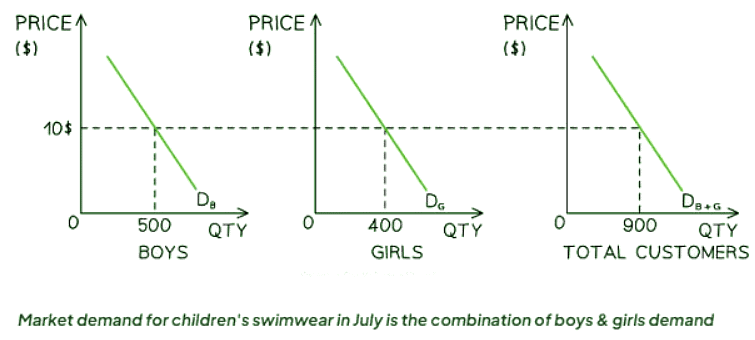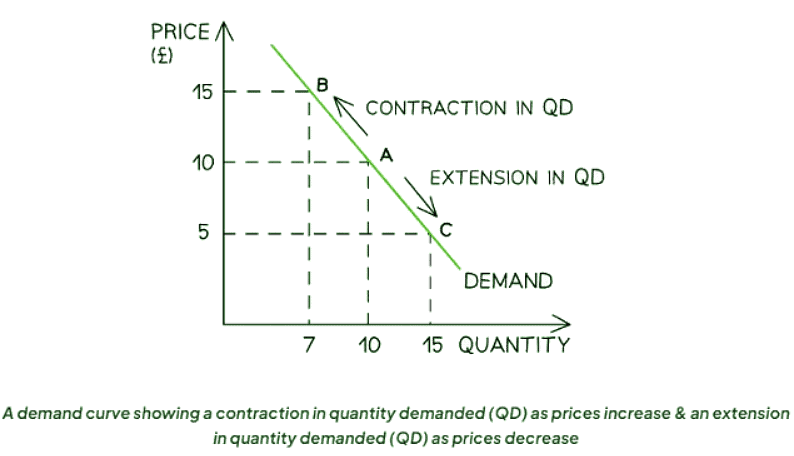Class 10 Exam > Class 10 Notes > Economics for GCSE/IGCSE > Demand, Price & Quantity
Demand, Price & Quantity | Economics for GCSE/IGCSE - Class 10 PDF Download
Introduction to Demand
- Demand: It refers to the volume of a product or service that a consumer is ready to purchase at a particular price within a defined timeframe. Effective demand exists when a consumer both desires and can afford a good or service.
- Demand Curve: This curve displays the correlation between the price of a product and the amount consumers are willing to buy. While real-world data might create a curve, economists commonly use straight lines for clarity in analysis.
Individual & Market Demand
- Market demand aggregates the individual demand for a particular good or service.
- It is determined by summing up the individual demand quantities across different price levels.

- Individual & market demand can also be represented graphically

Diagram Analysis
Analyzing the diagram provided:
- A shop sells both boys and girls swimwear.
- In July, at a price of $10, the demand for boys swimwear is 500 units and for girls is 400 units.
- At a price of $10, the shop's market demand during July is 900 units.
Movements Along a Demand Curve
- If price is the only factor that changes (ceteris paribus), there will be a change in the quantity demanded (QD). This change is shown by a movement along the demand curve.

Diagram Analysis
- The Law of Demand:
- The law of demand explains the inverse relationship between the price of a good and the quantity demanded.
- When prices increase, the quantity demanded decreases, and when prices decrease, the quantity demanded increases.
- Price Increase Effects:
- An increase in price from £10 to £15 results in a movement up the demand curve from point A to B.
- This leads to a contraction in quantity demanded, where the quantity falls from 10 to 7 units.
- For instance, if the price of a popular toy increases, fewer people may be willing to buy it, leading to a decrease in sales.
- Price Decrease Effects:
- A decrease in price from £10 to £5 leads to a movement down the demand curve from point A to C.
- This results in an extension in quantity demanded, where the quantity increases from 10 to 15 units.
- For example, if the price of a product decreases, more consumers may be attracted to buy it, leading to higher sales volume.
- Understanding the Inverse Relationship between Price and Quantity Demanded:
- There exists a fundamental inverse relationship between the price of a product and the quantity demanded (QD).
- When the price of a product increases, the quantity demanded by consumers tends to decrease.
- Conversely, when prices fall, the quantity demanded typically rises.
Question for Demand, Price & QuantityTry yourself: What is the relationship between price and quantity demanded according to the law of demand?View Solution
The document Demand, Price & Quantity | Economics for GCSE/IGCSE - Class 10 is a part of the Class 10 Course Economics for GCSE/IGCSE.
All you need of Class 10 at this link: Class 10
|
57 videos|110 docs|40 tests
|
FAQs on Demand, Price & Quantity - Economics for GCSE/IGCSE - Class 10
| 1. How does a change in price affect movements along a demand curve? |  |
Ans. A change in price leads to movements along a demand curve, as it causes a change in the quantity demanded of a good or service. When the price decreases, the quantity demanded usually increases, resulting in a movement down the demand curve. Conversely, when the price increases, the quantity demanded typically decreases, leading to a movement up the demand curve.
| 2. What factors can cause shifts in the demand curve? |  |
Ans. Several factors can cause shifts in the demand curve, including changes in consumer preferences, income levels, prices of related goods, population demographics, and advertising or marketing efforts. These factors can lead to an increase or decrease in the overall demand for a product or service, shifting the demand curve to the right or left accordingly.
| 3. How do changes in income levels impact demand movements along a demand curve? |  |
Ans. Changes in income levels can affect demand movements along a demand curve. For normal goods, an increase in income leads to an increase in demand, shifting the demand curve to the right. Conversely, for inferior goods, an increase in income can lead to a decrease in demand, shifting the demand curve to the left.
| 4. Can changes in consumer expectations impact movements along a demand curve? |  |
Ans. Yes, changes in consumer expectations can impact movements along a demand curve. If consumers expect prices to increase in the future, they may increase their current demand, leading to a rightward shift in the demand curve. Conversely, if consumers expect prices to decrease in the future, they may decrease their current demand, resulting in a leftward shift in the demand curve.
| 5. How do complementary goods affect demand movements along a demand curve? |  |
Ans. Complementary goods are products that are typically consumed together. A change in the price of a complementary good can impact demand movements along a demand curve. For example, if the price of coffee (complementary to coffee mugs) decreases, the demand for coffee mugs may increase, leading to a rightward shift in the demand curve. Conversely, if the price of coffee increases, the demand for coffee mugs may decrease, resulting in a leftward shift in the demand curve.
Related Searches





















